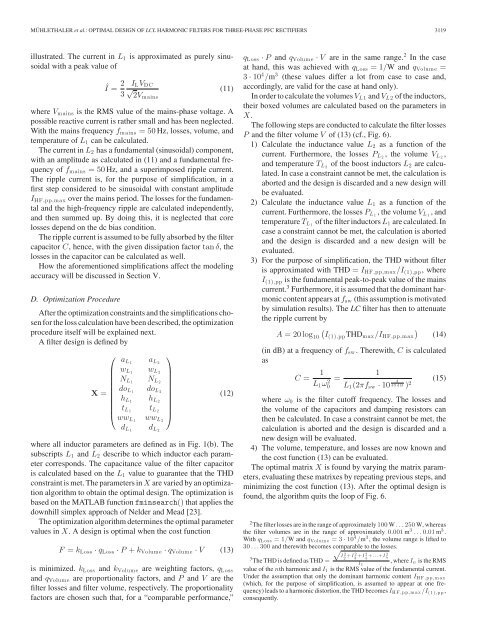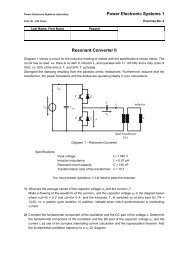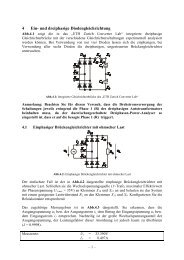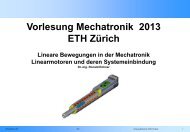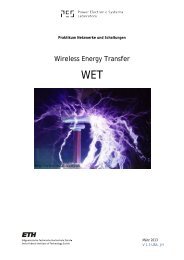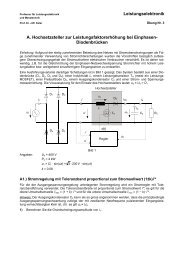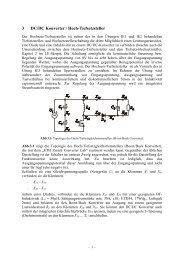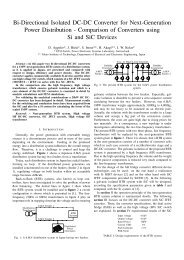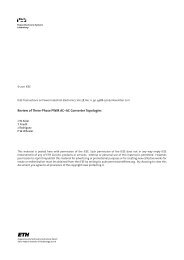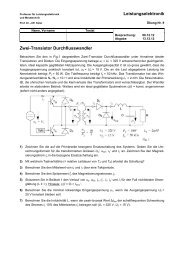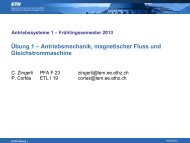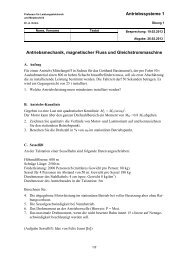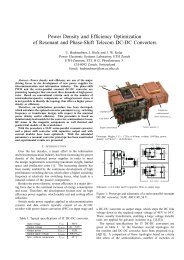Optimal Design of LCL Harmonic Filters for Three-Phase PFC ...
Optimal Design of LCL Harmonic Filters for Three-Phase PFC ...
Optimal Design of LCL Harmonic Filters for Three-Phase PFC ...
Create successful ePaper yourself
Turn your PDF publications into a flip-book with our unique Google optimized e-Paper software.
MÜHLETHALER et al.: OPTIMAL DESIGN OF <strong>LCL</strong> HARMONIC FILTERS FOR THREE-PHASE <strong>PFC</strong> RECTIFIERS 3119<br />
illustrated. The current in L 1 is approximated as purely sinusoidal<br />
with a peak value <strong>of</strong><br />
Î = 2 I L V<br />
√ DC<br />
(11)<br />
3 2Vmains<br />
where V mains is the RMS value <strong>of</strong> the mains-phase voltage. A<br />
possible reactive current is rather small and has been neglected.<br />
With the mains frequency f mains =50Hz, losses, volume, and<br />
temperature <strong>of</strong> L 1 can be calculated.<br />
The current in L 2 has a fundamental (sinusoidal) component,<br />
with an amplitude as calculated in (11) and a fundamental frequency<br />
<strong>of</strong> f mains =50Hz, and a superimposed ripple current.<br />
The ripple current is, <strong>for</strong> the purpose <strong>of</strong> simplification, in a<br />
first step considered to be sinusoidal with constant amplitude<br />
I HF,pp,max over the mains period. The losses <strong>for</strong> the fundamental<br />
and the high-frequency ripple are calculated independently,<br />
and then summed up. By doing this, it is neglected that core<br />
losses depend on the dc bias condition.<br />
The ripple current is assumed to be fully absorbed by the filter<br />
capacitor C, hence, with the given dissipation factor tan δ, the<br />
losses in the capacitor can be calculated as well.<br />
How the a<strong>for</strong>ementioned simplifications affect the modeling<br />
accuracy will be discussed in Section V.<br />
D. Optimization Procedure<br />
After the optimization constraints and the simplifications chosen<br />
<strong>for</strong> the loss calculation have been described, the optimization<br />
procedure itself will be explained next.<br />
A filter design is defined by<br />
⎛<br />
⎞<br />
a L 1<br />
a L 2<br />
w L 1<br />
w L 2<br />
N L 1<br />
N L 2<br />
do<br />
X = L 1<br />
do L 2<br />
h L 1<br />
h L 2<br />
⎜ t L<br />
⎝<br />
1<br />
t L 2<br />
⎟<br />
⎠<br />
ww L 1<br />
ww L 2<br />
d L 1<br />
d L 2<br />
(12)<br />
where all inductor parameters are defined as in Fig. 1(b). The<br />
subscripts L 1 and L 2 describe to which inductor each parameter<br />
corresponds. The capacitance value <strong>of</strong> the filter capacitor<br />
is calculated based on the L 1 value to guarantee that the THD<br />
constraint is met. The parameters in X are varied by an optimization<br />
algorithm to obtain the optimal design. The optimization is<br />
based on the MATLAB function fminsearch() that applies the<br />
downhill simplex approach <strong>of</strong> Nelder and Mead [23].<br />
The optimization algorithm determines the optimal parameter<br />
values in X. A design is optimal when the cost function<br />
F = k Loss · q Loss · P + k Volume · q Volume · V (13)<br />
is minimized. k Loss and k Volume are weighting factors, q Loss<br />
and q Volume are proportionality factors, and P and V are the<br />
filter losses and filter volume, respectively. The proportionality<br />
factors are chosen such that, <strong>for</strong> a “comparable per<strong>for</strong>mance,”<br />
q Loss · P and q Volume · V are in the same range. 2 In the case<br />
at hand, this was achieved with q Loss =1/W and q Volume =<br />
3 · 10 4 /m 3 (these values differ a lot from case to case and,<br />
accordingly, are valid <strong>for</strong> the case at hand only).<br />
In order to calculate the volumes V L1 and V L2 <strong>of</strong> the inductors,<br />
their boxed volumes are calculated based on the parameters in<br />
X.<br />
The following steps are conducted to calculate the filter losses<br />
P and the filter volume V <strong>of</strong> (13) (cf., Fig. 6).<br />
1) Calculate the inductance value L 2 as a function <strong>of</strong> the<br />
current. Furthermore, the losses P L 2<br />
,thevolumeV L 2<br />
,<br />
and temperature T L 2<br />
<strong>of</strong> the boost inductors L 2 are calculated.<br />
In case a constraint cannot be met, the calculation is<br />
aborted and the design is discarded and a new design will<br />
be evaluated.<br />
2) Calculate the inductance value L 1 as a function <strong>of</strong> the<br />
current. Furthermore, the losses P L 1<br />
,thevolumeV L 1<br />
, and<br />
temperature T L 1<br />
<strong>of</strong> the filter inductors L 1 are calculated. In<br />
case a constraint cannot be met, the calculation is aborted<br />
and the design is discarded and a new design will be<br />
evaluated.<br />
3) For the purpose <strong>of</strong> simplification, the THD without filter<br />
is approximated with THD = I HF,pp,max /I (1),pp , where<br />
I (1),pp is the fundamental peak-to-peak value <strong>of</strong> the mains<br />
current. 3 Furthermore, it is assumed that the dominant harmonic<br />
content appears at f sw (this assumption is motivated<br />
by simulation results). The LC filter has then to attenuate<br />
the ripple current by<br />
( )<br />
A = 20 log 10 I(1),pp THD max /I HF,pp,max (14)<br />
(in dB) at a frequency <strong>of</strong> f sw . Therewith, C is calculated<br />
as<br />
C = 1<br />
1<br />
L 1 ω0<br />
2 =<br />
(15)<br />
L 1 (2πf sw · 10 A<br />
40 dB ) 2<br />
where ω 0 is the filter cut<strong>of</strong>f frequency. The losses and<br />
the volume <strong>of</strong> the capacitors and damping resistors can<br />
then be calculated. In case a constraint cannot be met, the<br />
calculation is aborted and the design is discarded and a<br />
new design will be evaluated.<br />
4) The volume, temperature, and losses are now known and<br />
the cost function (13) can be evaluated.<br />
The optimal matrix X is found by varying the matrix parameters,<br />
evaluating these matrixes by repeating previous steps, and<br />
minimizing the cost function (13). After the optimal design is<br />
found, the algorithm quits the loop <strong>of</strong> Fig. 6.<br />
2 The filter losses are in the range <strong>of</strong> approximately 100 W ...250 W, whereas<br />
the filter volumes are in the range <strong>of</strong> approximately 0.001 m 3 ...0.01 m 3 .<br />
With q Loss =1/W andq Volume =3· 10 4 /m 3 , the volume range is lifted to<br />
30 ...300 and therewith becomes comparable to the losses.<br />
√<br />
I 2 2 + I 2 3 + I 2 4 + ...+ I 2 n<br />
3 The THD is defined as THD =<br />
I 1<br />
,whereI n is the RMS<br />
value <strong>of</strong> the nth harmonic and I 1 is the RMS value <strong>of</strong> the fundamental current.<br />
Under the assumption that only the dominant harmonic content I HF,pp,max<br />
(which, <strong>for</strong> the purpose <strong>of</strong> simplification, is assumed to appear at one frequency)<br />
leads to a harmonic distortion, the THD becomes I HF,pp,max /I (1),pp ,<br />
consequently.


